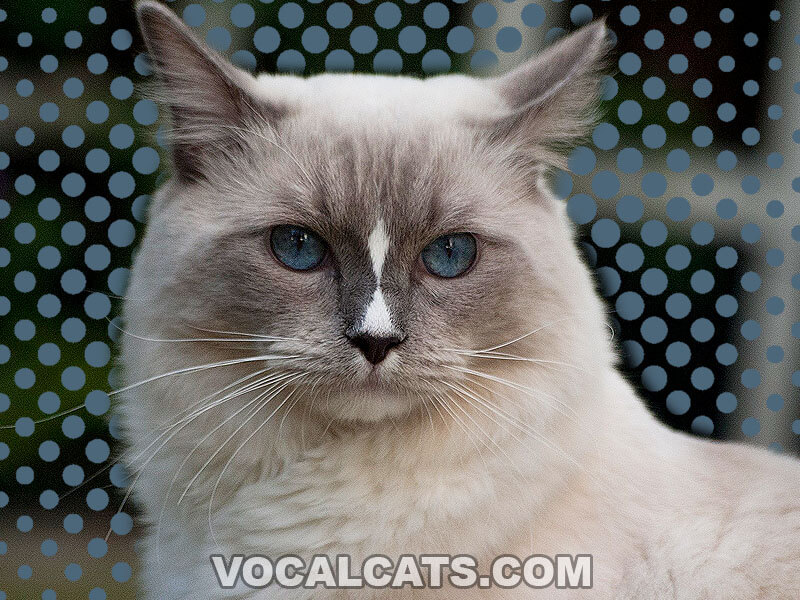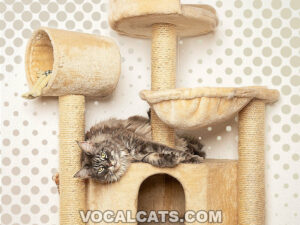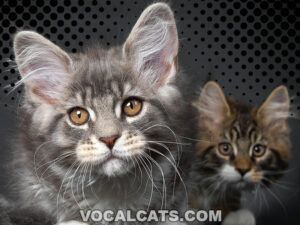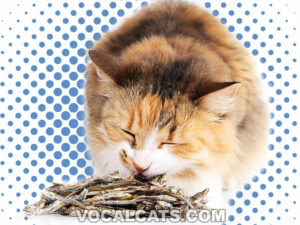Cats are said to be solitary creatures that prefer to be alone. But this is not the case with a Blue Lynx Ragdoll that adores human companionship and is one of the sweetest cat breeds around.
In this article, I’d like to share with you my personal experiences of living with a Blue Lynx Ragdoll. For one, my kids adore her because she does not mind being carried and snuggled up. And, it’s easy to tag her along in our morning walks because we were able to leash-train her at a young age.
The Blue Lynx Ragdoll is one of the color patterns of a Blue Ragdoll Cat. In this guide, I’d like to partake with you on how you can properly care for your kitty, such as the best kind of cat food, how to groom and train your cat, and much more. So, let’s begin our interesting discussion about this beautiful and adorable cat breed.
Contents
- Blue Lynx Ragdoll: Breed overview
- What is a Blue Lynx Ragdoll?
- Blue Lynx Point Ragdoll: Parent breeds
- Is the Blue Lynx Ragdoll Cat recognized by cat registries?
- Blue Lynx point Ragdoll Cat physical appearance
- Lynx Blue Ragdoll size, height, and weight
- Various Blue Lynx Ragdoll coat colors and types
- What is the personality of a Blue Lynx Ragdoll?
- Lynx Blue point Ragdoll temperament
- Do Ragdoll Blue Lynx make great family pets?
- Blue Lynx colorpoint Ragdoll training
- Blue point Lynx Ragdoll Cat exercise requirement
- Ragdoll Blue Lynx point grooming and cleaning
- Do Blue Lynx Ragdoll shed a lot?
- Are Blue Lynx Ragdolls hypoallergenic?
- Blue Lynx colorpoint Ragdoll Cat food and diet
- Blue Lynx Ragdoll common health issues
- Blue Lynx Ragdoll lifespan
- Ragdoll Blue point Lynx breeders
- Blue Lynx Ragdoll kitten
- How much is a Blue Lynx Ragdoll?
- Places to find Blue Lynx Ragdoll kittens for sale
- Finding a healthy Blue Lynx Ragdoll for sale
- Blue Lynx Ragdoll: Pros and Cons
- Is the Blue Lynx Ragdoll right for me?
- Related Questions
Blue Lynx Ragdoll: Breed overview
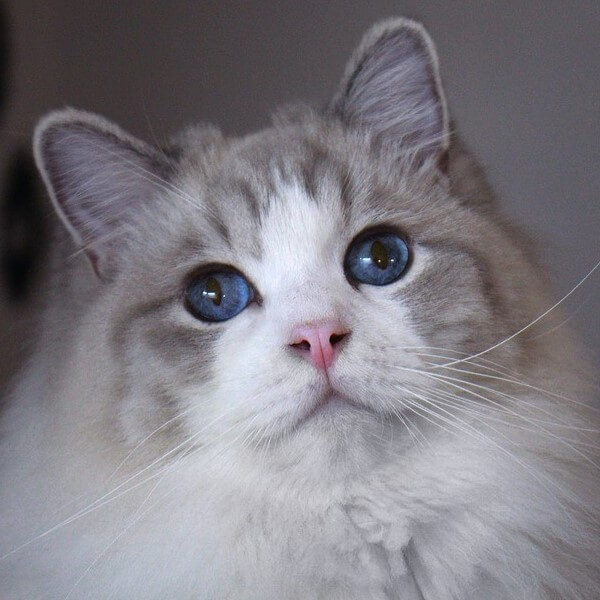
Here is a table on what you can briefly expect from your Blue colorpoint Lynx Ragdoll cat.
| Other names | Blue Lynx point Ragdoll, Blue colorpoint Lynx Ragdoll |
| Size | Large |
| Weight | 15 – 20 pounds |
| Height | 9 – 11 inches |
| Coat Colors | Gray, White |
| Child Friendliness | High |
| Feline Friendliness | High |
| Training Difficulty | Moderate |
| Grooming Upkeep | Moderate – High |
| Exercise Needs | Low – Moderate |
| Health | Moderate |
| Lifespan | 12 – 16 years |
| Kitten Cost | $1,000 – $2,500 |
RECOMMENDED: White Ragdoll Cat (Complete Guide)
What is a Blue Lynx Ragdoll?
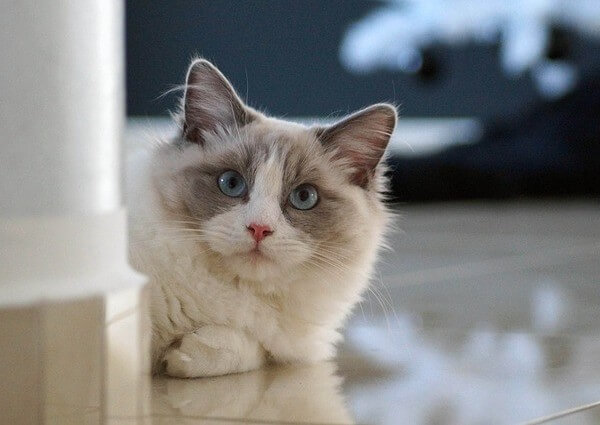
A Blue Lynx Ragdoll is one of the official color variations of the Ragdoll. They have a white to platinum gray body coat with points in the face, ears, paws, and tails. The points have deep blue bars or tabby stripes separated by a lighter background.
Blue Lynx Point Ragdoll: Parent breeds
The Blue Lynx Point Ragdoll is a purebred domesticated cat. They were developed initially from a female long-haired Angora-type cat with a seal-mitted color pattern with males that are of the Birman-type.
READ ALSO: Seal Mitted Ragdoll (Complete Guide)
The Angora, or Turkish Angora, is a medium-sized cat characterized by a long, slender physique with single-coated silky fur that comes in a variety of colors and patterns. They are active and sociable that love the company of their family with a tendency to be needy.
On the one hand, Birman cats are known for their colorpointed coat. They are easygoing and gentle with a propensity of following their owners most of the time giving them the moniker “velcro” cats.
Ragdoll history
The Ragdoll was developed during the 1960s by Ann Baker in Riverside, California. The matriarch of the breed is a non-pedigreed, domestic long-haired female, named Josephine.
Baker then crossed this female with several cats she owned eventually producing offspring over several generations with a colorpoint coat and a docile temperament. She named it Ragdoll because the cat tended to go limp when carried.
DON’T MISS: Best Cat Tree For Ragdolls (Reviews & Top Picks)
Is the Blue Lynx Ragdoll Cat recognized by cat registries?
Yes, the Blue Lynx Ragdoll Cat is recognized by major cat registries, such as the Cat Fanciers’ Association (CFA) and The International Cat Association (TICA).
Blue Lynx point Ragdoll Cat physical appearance
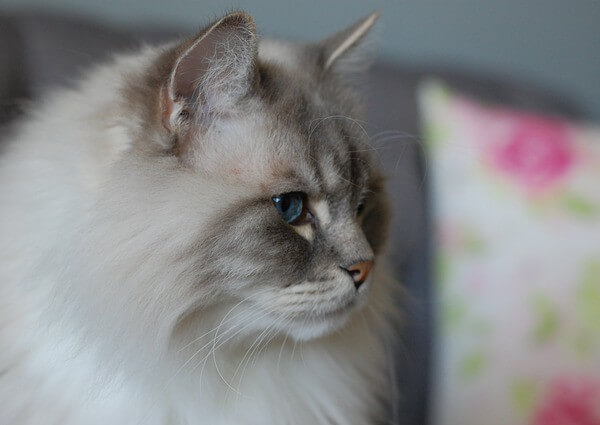
Blue Lynx point Ragdoll Cat presents with a sturdy, rectangular body and long-plumed tail. They have a large, broad head that is equilateral on all sides with a gently rounded muzzle.
Blue Lynx Ragdolls have a bluish-white to grayish-white body coat with some having faint markings of tabby or ticking. The points on the face, ears, legs, and tail have a deep bluish-gray color that is separated by a lighter color similar to a lynx. There is also the characteristic ‘M’ pattern on the forehead.
Eyes are large and oval in shape that is blue. They have large, tufted paws with pads that are grayish. Nose leather is grayish as well with pink edges.
CHECK OUT: Grey Ragdoll Cat (Complete Guide)
Lynx Blue Ragdoll size, height, and weight
Lynx Blue Ragdoll is large with a body length that can reach 17 to 21 inches from the nose to the base of the tail. They typically grow in spurts until they reach their final height and weight between 4 and 5 years of age.
| Size | Height | Weight |
| Male | 9.5 – 11 inches | 12 – 20 pounds |
| Female | 9 – 10 inches | 8 – 15 pounds |
Blue Lynx Teacup Ragdoll
Blue Lynx teacup Ragdoll is a smaller version of the standard Blue Lynx Ragdoll. They are produced by crossing runts of litter and are more prone to health issues due to their size.
A mature Blue Lynx teacup Ragdoll can weigh as tiny as 5 to 6 pounds compared to a standard-sized Ragdoll which weighs 20 pounds. They are hard to find and can set you back several thousand dollars.
Various Blue Lynx Ragdoll coat colors and types
Blue Lynx Ragdolls come in various types depending on the pattern of the points in the extremities. The body coat could also have some shading or ticking of some other light color in the saddle area.
Blue Lynx Bicolor Ragdoll
Blue Lynx bicolor or a Blue Lynx point bicolor Ragdoll presents with bluish gray points on the ears, mask, and tail only. The legs and paws are white in a Blue bicolor Lynx Ragdoll.
The chin, chest, and tummy are white in a Ragdoll Blue Lynx bicolor with some exhibiting a light bluish-gray shading on the saddle area. An inverted white ‘V-shaped mark on the outer edge of the eyes is typical in a Ragdoll Blue bicolor Lynx.
Blue Lynx bicolor Ragdoll kitten is born with a white coat with a bluish-gray color appearing around the third month.
Blue Lynx Mitted Ragdoll
Blue Lynx mitted Ragdoll Cat or Blue Lynx point mitted Ragdoll presents with bluish gray points on the face, ears, legs, and tail except for the white paws. The points in a Ragdoll Blue Lynx mitted have distinct bars or stripes of light and dark shades.
The body coat of a Blue mitted Lynx Ragdoll or mitted Blue Lynx Ragdoll is bluish-white with lighter shading around the tummy and chest.
The chin is also white that extends to the belly. Some Blue point Lynx mitted Ragdoll exhibit a white blaze in the shape of a diamond between the nose and forehead.
Blue mitted Lynx Ragdoll Cat has a slate-colored nose leather that has pink edges and the paw pads of a Ragdoll Blue mitted Lynx is also dark gray.
As with all Ragdolls, a Blue Lynx mitted Ragdoll kitten will retain the blue eye color into adulthood.
DON’T MISS: Blue Eyed White Ragdoll (Complete Guide)
Blue Lynx Mink Ragdoll
Blue mink Lynx Ragdoll presents with a darker colored bluish gray body coat compared to the standard Blue point Lynx Ragdoll with a colder light bluish-white coat. Mink Ragdolls, in general, are not recognized by cat registries as part of the standard Ragdoll breed due to their coloration.
Blue Cream Lynx Point Ragdoll
Blue cream Lynx point Ragdoll presents with a bluish-white body coat with some cream mottling on the coat as well as on the points.
RELATED: Cream Point Ragdoll (Complete Guide)
Blue Lynx Tabby Ragdoll
Blue tabby Lynx Ragdoll is another term for Blue Lynx Ragdoll. The points on the face, ears, tail, and legs are composed of deep bluish-gray bars separated by a lighter color.
Blue Lynx Bicolour Ragdoll
The Blue Lynx bicolour Ragdoll is similar to the Blue Lynx Bicolor Ragdoll with deep bluish gray points found on the face, ears, and tail only with the legs and paws being white.
What is the personality of a Blue Lynx Ragdoll?
Blue Lynx Ragdolls, just like any Ragdoll, have a docile and calm personality. They are pretty laid back and enjoy the company of their family without being too demanding.
They have a dog-like disposition, love to follow their owners around, and enjoy being caressed and cuddled.
Lynx Blue point Ragdoll temperament
Lynx Blue Point Ragdoll is generally a relatively quiet breed that would only meow occasionally when they seek attention or get excited. Ragdolls also prefer staying low on the ground as opposed to other breeds that are climbers.
Do Ragdoll Blue Lynx make great family pets?
Yes, the Ragdoll Blue Lynx is a great addition to most families. Our cat does not exhibit any aggressive behaviors at all which makes her ideal pet for my kids. Our Ragdoll Blue Lynx is also very tolerant and friendly to our other cat-friendly pets due to her docile nature.
You may be interested in: Are Ragdoll Cats Talkative Or Vocal?
Blue Lynx colorpoint Ragdoll training
Blue Lynx colorpoint Ragdoll is a smart and sociable breed, so they are fairly easy to train. Basic behaviors, such as using a litter box or setting rules around the house, can begin as young as 3 to 4 weeks old.
Use positive reinforcement techniques, like giving treats and petting, to develop good behavior.
DON’T MISS: Cat Scratching Litter Box Excessively: 10 Reasons Why & What To Do!
Blue point Lynx Ragdoll Cat exercise requirement
I engage my Blue Point Lynx Ragdoll Cat in a 10 to 15-minute exercise 2 to 3 times daily. She prefers short bursts of physical activity and is more content lounging around our house most of the day.
I recommended exercises that include interactive games like chasing a laser pointer or a fishing pole toy. They can also be taken for short walks while on a leash or harness to mentally stimulate their senses and let them explore new things and situations.
Ragdoll Blue Lynx point grooming and cleaning
I began grooming my Ragdoll Blue Lynx as soon as I brought her home. I invested in some tools to manage her long and luscious coat. Let me share with you grooming and cleaning tips for a Ragdoll Blue Lynx point cat:
Brushing
- First, I get a wide-tooth comb to untangle the mats. On some days, I also use a flea comb to take care of stubborn mats.
- Second, I brush her coat with a de-shedding brush to get rid of loose and dead hair. I also find this tool great to minimize shedding.
- Lastly, I rely on a soft-bristled brush to distribute the natural oil to make her coat softer and shinier.
Bathing
Cats are by nature clean animals. Their tongues are made up of millions of rough particles called papillae that work like a body scrub.
This is why I only bathe my cat when she gets in contact with sticky particles or when she starts to emit a bad smell. I use a feline-friendly shampoo that is devoid of strong detergents.
Teeth Brushing
I don’t take for granted cleaning her teeth and gums because if I do, it will lead to periodontal diseases.
I use a small toothbrush for cats so I can reach the corners of her mouth. It’s best to use an enzymatic toothpaste because it does not contain peroxide and is available in different flavors that my kitty loves.
Nail Trimming
I always trim the nails of our Blue Lynx Ragdoll. This is to avoid her from accidentally scratching the skin of my kids while playing. And, since she is an indoor kitty, her ‘manicured nails’ prevent her from damaging carpet and upholstered sofas.
I cut just the tip of her nails to prevent me from cutting the pink portion or the quick. Admittedly though, I sometimes got too close to the quick, so bleeding happened. Having styptic powder in hand is very helpful in stopping the bleeding.
Ear/Eye Cleaning
I don’t neglect cleaning the eyes and ears of our cat. A simple moistened cotton ball is all it takes to get rid of ear wax and eye boogers. This simple routine prevents infections that can worsen over time.
| Grooming Needs | Grooming Frequency |
| Hair Brushing | 3 – 4x weekly |
| Nail Trimming | 2x/month |
| Teeth Brushing | 2 -3x weekly |
| Bathing | Once a month or fewer |
| Eye Care | Check weekly |
| Ear Care | Check weekly |
Do Blue Lynx Ragdoll shed a lot?
Shedding is a natural process that keeps her coat healthy. So, yes, our Blue Lynx Ragdoll sheds her coat year-round but it gets worse during spring and fall.
But, my family and I are not bothered because I use a vacuum cleaner with a HEPA filter. The strong suction power of the vacuum cleaner picks up even the tiniest particles, such as cat litter, cat fur and dander, thereby, keeping our house clean.
RELATED: Do Ragdoll Cats Shed? 7 Ways To Shed Less!
Are Blue Lynx Ragdolls hypoallergenic?
No, a Blue Lynx Ragdoll can cause allergic reactions in sensitive people. This is due to the Fel d1 protein that is present in the saliva and sebaceous glands.
Thankfully, I found an effective way to keep our indoor air clean and allergen-free.
I use an air purifier with a HEPA filter which I found effective in capturing allergens and in eliminating pet odor around our home.
CHECK OUT: Do Ragdoll Cats Sneeze A Lot? 15 Reasons & How To Help
Blue Lynx colorpoint Ragdoll Cat food and diet
A Blue Lynx colorpoint Ragdoll needs a diet that is loaded with protein. Good sources of protein include fish, chicken, and lamb.
Apart from protein, I choose cat food that contains Omega-3 fatty acids for healthy skin and coat and for a healthy immune system.
You may also like: Can Cats Eat Mackerel? (Raw, Canned, Oil, Tomato Sauce)
Blue Lynx Ragdoll common health issues
I got my Blue Lynx Ragdoll kitty from a responsible breeder who showed me the results of the DNA test of his breeding cats.
If you would like to know what health issues your Ragdoll is most susceptible to, here is an easy cat DNA test kit you can use right in the comfort of your own home. It tells you your Ragdoll’s genetic makeup and what specific health conditions he or she is predisposed to so you are aware and can plan accordingly.
For now, here are four (4) health issues that can affect your Blue Lynx Ragdoll:
1. Hypertrophic Cardiomyopathy (HCM)
A hereditary disease that causes the left ventricle to thicken. This results in decreased blood and oxygen circulation. Some signs are coughing and weakness.
2. Polycystic Kidney Disease (PKD)
A genetic disorder wherein the affected cats may suffer from kidney failure due to the growing number of fluid-filled cysts in their kidneys.
3. Gastrointestinal Disorders
A Ragdoll is prone to develop issues in the gastrointestinal tract. The causes may be due to feline enteritis, poor diet, or obstruction in their bowel. Vomiting and diarrhea are two of the common signs.
4. Feline Leukemia Virus (FeLV)
This is one of the leading causes of death among cats, this is a transmittable disease causing anemia and weakened immune system.
Blue Lynx Ragdoll lifespan
The average life expectancy of a Blue Lynx Ragdoll is from 12 to 16 years.
Ragdoll Blue point Lynx breeders
I spent time and effort in search of the best breeder that I can find to get my family’s Ragdoll Blue Point Lynx. Here are the characteristics of a good breeder you also need to look for:
- The breeders’ websites should include important information such as their affiliations with cat associations like TICA, the DNA test results of their breeding cats, and customer feedback.
- Good breeders raise their kittens in an underfoot environment, meaning, the kitties are allowed to interact with people and animals.
- Good breeders provide a health guarantee against congenital diseases.
Blue Lynx Ragdoll kitten
Before I brought home my family’s Blue Lynx point Ragdoll kitten, all the things she needs are already in place. These are:
- Kitty bed that is placed in a quiet area inside our home
- A kitty carrier that is large enough for comfort
- A collar and a leash
- Litter box and a non-clumping litter
- Feeding and drinking bowls
- Toys such as scratchers and catnip-filled toys
READ ALSO: Do Ragdoll Cats Scratch Furniture?
How much is a Blue Lynx Ragdoll?
The cost of a Blue Lynx Ragdoll can be anywhere from $1,000 to $2,500. But it’s not impossible to find a kitten with a price tag of $3,000 if it comes from show-quality parents.
Places to find Blue Lynx Ragdoll kittens for sale
To help you locate reputable breeders who may have an available Blue Lynx Ragdoll kitten for sale, here are 3 places to go to:
- A Blue Lynx mitted Ragdoll kitten for sale may be currently available at Belden Blue Ragdolls (beldenblueragdolls.com) in the USA. The average price of the kittens is $1,000.
- If you’re from Canada and still on the lookout for Blue Lynx Ragdoll kittens for sale near me, you may want to check out Sweet Fairy Doll Cattery (sweetfairydoll.com). The kings and queens (breeding parents) all tested negative for PKD and HCM.
- For anyone of you living in Australia, I suggest that you go to the webpage of Everdolls Ragdolls (everdollsragdolls.com). You can request to see all the DNA tests and other laboratory results of the breeding parents and the kittens.
Finding a healthy Blue Lynx Ragdoll for sale
Adult cats are as endearing, so here is a short list of where to look for an adult Blue Lynx point Ragdoll for sale.
- You can go to the website of Starlite Rags (starliterags.net/available-adults) in the USA if the breeder currently has an adult Blue Lynx Ragdoll for adoption.
- You can also reach out to the owner of the TICA-registered cattery, the Masterpiece Ragdolls (masterpieceragdolls.com/retiredadults) in the USA.
Blue Lynx Ragdoll: Pros and Cons
| Pros | Cons |
| Trainable | Expensive to buy |
| Doesn’t need much exercise | Not hypoallergenic |
| Affectionate | Prone to separation anxiety |
| Child-friendly | Moderate shedder |
| Physically-appealing | Prone to joint problems |
| Relatively quiet | Needs regular grooming |
Is the Blue Lynx Ragdoll right for me?
If you are a homebody or someone who belongs to a household where there is always someone around, then the Blue Lynx Ragdoll can be the right breed for you. Just like most Ragdolls, the Blue Lynx Ragdolls love the company of their family and cannot be left alone for long hours.
Related Questions
The rarest Ragdoll color variation is the Lilac Ragdoll. Their coat color is lighter than a Blue Ragdoll with a very light bluish-gray hue and pinkish lavender points. They are uncommon because Lilac Ragdolls must carry 2 copies of the recessive chocolate gene and the dilution gene.
DISCLAIMER: THIS WEBSITE DOES NOT PROVIDE MEDICAL ADVICE
The information, including but not limited to, text, graphics, images and other material contained on this website are for informational purposes only. No material on this site is intended to be a substitute for professional veterinary advice, diagnosis, or treatment. Always seek the advice of your veterinarian or other qualified health care provider with any questions you may have regarding a medical condition.
Resources:
https://en.wikipedia.org/wiki/Ragdoll
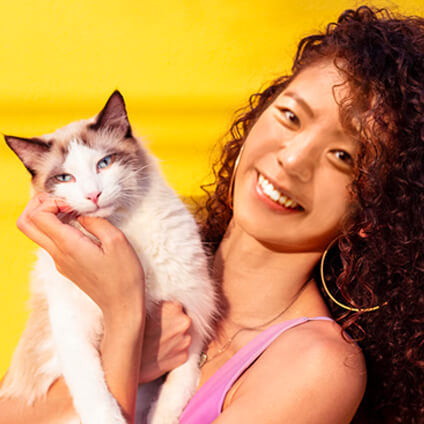
With over five years of specialized experience as an animal writer, my expertise lies in cat nutrition, health, behavior, grooming, and training. I am dedicated to delivering helpful and informative content that caters to the well-being of our feline friends. My primary goal is to empower pet owners with knowledge and ensure our feline companions thrive in health and happiness. In my free time, I love volunteering at local cat rescue centers.
